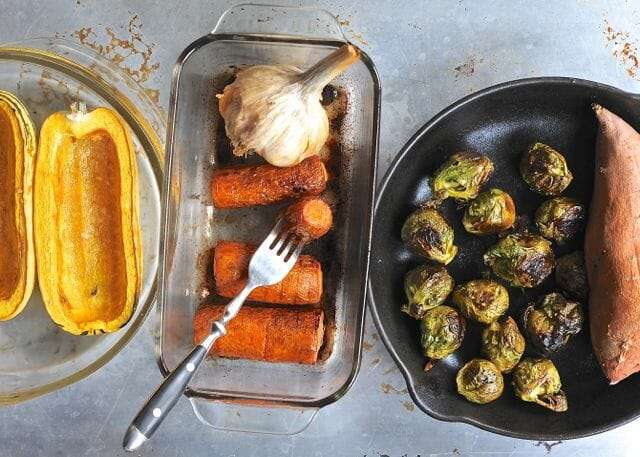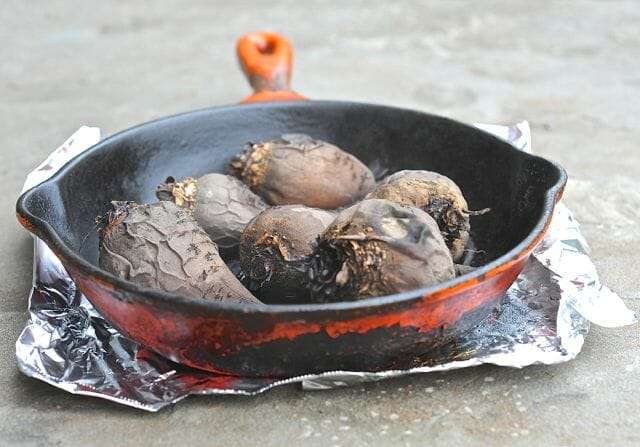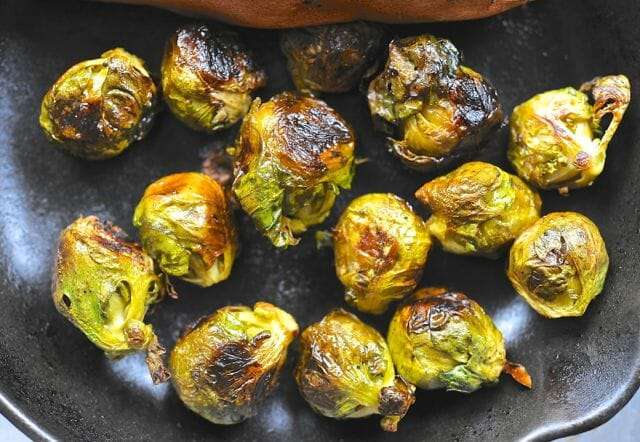roasted vegetables, a sunday tradition

HERE’S ANOTHER RECIPE that doesn’t require a recipe—you know, like my “baked pears,” when the dish’s name itself tells you the whole story. Instead of baking pears, I’m making roasted vegetables this weekend, as I do most every week in giant batches. But I suppose there are always questions, such as: peel first, or not, or how hot should the oven be, and what do I dress the vegetables with first?
My favorite vegetable candidates in the cold weather months include parsnips, carrots, turnips, rutabaga, sweet potatoes, white potatoes, winter squash, onions, heads of garlic, beets (segregate if red-colored to prevent staining of neighbors), Brussels sprouts, cauliflower, kale, broccoli, broccoli raab. I hate fennel, but it roasts well. So do leeks. (In summer, when I have them, I do peppers, eggplant and summer squash.)
For efficiency: Since the oven’s on, I usually fill both racks and bake a whole sweet or white potato or some halved squash, too, as in the top photo, or a tray of marinated tofu, or, yes, even some more baked pears. Cooking up lots of vegetables at once means I have no excuse not to eat a portion at every meal, and even cold they make great snacks…or can become ingredients in other dishes, like these:
dishes to make with roasted vegetables
- Pasta: Toss into spaghetti or penne with good olive oil and some red pepper flakes and grated cheese (this is my favorite use for roasted cauliflower, broccoli raab or broccoli). Heidi Swanson’s recent roast squash and kale with orzo salad looks delicious, too.
- Over salad (halved Brussels sprouts are a favorite for this, perhaps tossed with vinaigrette, and topped with shaved hard cheese). Finely cubed mixed root vegetables, tossed in oil and balsamic and roasted, would make a great salad course on their own or over greens.
- In a tart shell or other pastry: Maybe layer roasted vegetables onto your favorite crust and melt some cheese on top, or make it more quiche-like with egg as well? Or skip the crust and just make a frittata.
MY LAISSEZ-FAIRE cooking style says that there’s a range of correct answers to all those detail questions, and I surveyed the experts, too:
roasted vegetable guidelines
- Temperature: Expert cooks suggest a 400-to-425-degree F oven. Ina Garten goes with 425, for instance. Be sure to preheat!
- If your oven causes the oiled veggies to smoke at that temperature, as mine can, 375 F will work, too, just slightly more slowly, and perhaps with less caramelizing.
- Technically, you want to cut up all your vegetables to the same approximate size, so they cook evenly, but I don’t unless I’m preparing a side dish of mixed roasted vegetables. I simply vary the cooking times by putting similar-sized things in their own pans and removing individual pans as the contents are done.
- Different vegetables in different sizes will take about 30 minutes to an hour, and your desired doneness is also a factor. For instance, I like the outsides of Brussels sprouts really deep brown, though they are “done” before that.
- I always clean the vegetables, but as for peeling, it’s optional if the skin is edible, such as potatoes (white or sweet); winter squash such as ‘Delicata,’ and even carrots and other roots. Often the browned skin after roasting is the tastiest part.
- I never peel beets (below), but rather slip their skins off after roasting. I cover them, either using foil or in a lidded, ovenproof cast-iron frying pan, as I do whole, untrimmed heads of garlic. Everything else I leave uncovered.
- A low-sided pan, such as for cookies, will result in best browning, though I do fine with pie and cake pans, including Pyrex, and even some old cast-iron frypans. Don’t overcrowd the pieces in the pan or they won’t brown.
- I typically use only olive oil and sea salt to dress my vegetables (though this extra-special homemade herbed salt is amazing). More flavor possibilities below.
- Don’t drizzle the oil over the vegetables when they are already in their baking pans. This leads to a smokier oven (and wasted oil). Toss vegetable pieces first instead in a big bowl with just a little oil and any other seasonings, before spreading the oiled pieces on the pan.
- If you’re adding fresh herbs, do so partway through cooking, maybe after 20 minutes, so they don’t incinerate.
- Shake the pan a few times during cooking to prevent sticking, or use tongs to turn things periodically.
what about added flavors?
- Again, olive oil and sea salt and pepper is the basic.
- Add balsamic vinegar to the above, or try a full-on balsamic dressing, perhaps with Dijon and crushed garlic, like this one.
- Herbed salts, or salt and some red pepper flakes or rosemary leaves, perhaps? (Again: I add fresh herbs late in the cooking period.)
- Moroccan-style spices are another possibility, including perhaps coriander, cumin, and even a little cinnamon and/or cayenne.
- Or maybe South Asian flavors such as curry powder, cardamom, garlic—you get the idea. (Jamie Oliver likes his summer vegetables, such as squash and peppers, with coriander and rosemary.)







If you’re using aromatic herbs and spices (cumin or rosemary), do you use just one type per oven full? I’d wonder about them blending.
Love that you put roasting veggies on your weekly schedule. A great way to have them on a busy work night!
What a simple and glorious tradition! Now that we have a veggie garden of our own I can feel this tradition being adopted on Serendipity Farm. Over our coming winter (in Northern Tasmania Australia) when Brunhilda (our wood burning oven) is fired up again, these humble roasted veggies can be our own, tumbled in some home made flavoured salt, a few home grown fragrant herbs tossed in or tossed gently in some delicious concoction of a dressing…plus if you do enough you can have them for other quick meals through the week. A wonderful tradition that will give a lot of us food for thought and something delicious to pass on :) Thank you for this post, and for this tradition :)
I love roasted vegetables. My favorite is roasted tomato because it becomes ‘sweet’. Sundays are the perfect days to make them. I always add a sprinkle of garlic powder too. It kicks it up a notch or two..
Margaret, my approach to roasting veggies is much like yours, except that I simply drizzle a little olive oil over the vegetables and then shake the pan vigorously to distribute the oil. I also often roast grape or cherry tomatoes whenever I have the oven heated up, and then they become the base for a pasta dish later in the week. I also follow the rule of separate pans for separate vegetables, as they all have slightly different roasting times.
I like to include whole sprigs of thyme. Chopped fresh rosemary and sage go well with certain veggies.
I think I owe you thanks for pointing me to the Smitten Kitchen website. I recently found blueberries on sale and when I checked Deb’s recipes under blueberries there were a dozen or more great suggestions. One of these days I’m going to try her custards with roasted blueberries–yum!
Thanks, Dahlink, for the tips — and glad you enjoyed Smitten Kitchen! She is great.
I find painting vegetables with olive oil using a pastry brush (I use a paint brush)
works very well.
Yum! Your garlic looks much white than mine. I read home grown garlic shouldn’t be washed after harvest. This is my first harvest and it sure is dirty! Yummy however. I saw a receipe for roasted veg, layered in a springform pan, lined w phyllo. I too am grateful for smitten kitchen, it has been a great resource.
Love roasted veggies! I found a lowbrow way to make potatoes or peppers. Use the small little tan potatoes, cut in half or thirds. Mix one package of dry French onion soup mix and about 1/4 C canola oil, plus 1 T Dijon mustard (gives it class) in a large bowl with sliced potatoes. Mix them up and roast per above. This concoction can be used on other vegetables as well. It has 1950s flavor.
Nice roundup! I usually throw some bacon, shallots and garlic on top of my halved brussels sprouts and roast them – absolutely delicious.
Thanks, Amy. My sister adds bacon to hers, too (me, I’m a vegetarian…but I know that would taste great!). Nice to see you.
Hi, Lynn. You made me laugh with the “1950s flavor” description! Indeed. Onion soup was the main “spice” then, right? :)
Roasted brussel sprouts are candy fare in our house! Cam’t get enough
i am new ..
I really enjoyed the comments. I can’t wait to start my garden.
LaRieta
So nice to “meet” you, Elarieta. Here, too. What I wouldn’t give today for the chance to turn a shovelful of warm soil!
Delighted to read that Narf7’s Serendipity Farm in Northern Tasmania Australia has a cookstove named Brunhilda! The Germanic/Swedish “kitchen witch” to protect against, among other things, bad cooking. In my first home in 1990s I too named my kitchen stove Brunhilda, and the washing machine Brunhildino. Even put up a Brunhilda Kitchen Doll (like a root vegetable.) In histories and folklores, she is the strong efficient co-creators of happy domestic hearths. Yes, Brunhilda would definitely approve of Margaret, Jack, and Intensely Rich Roasted Veggies.
I think we are kindred cooks! I add mushrooms to my mix too…. And chile pepper flakes.
When we got a convection oven I found that vegies browned on the outside before they were cooked on the inside. So I have learned to not use the convection setting when roasting.
Roast parsnips….yummm….
Hi, Muriel. I think my oven has that feature but I have never used it! :) Love parsnips here too — so sweet.
Welcome, Frances. That sounds like a roasted feast! A great assortment of flavors.
Thanks to you both for saying hello.
You inspired me, Margaret! My midday Sunday roast included sweet potatoes, onion slices, red bell pepper slices, carrots, taro, garlic, pumpkin, asparagus, kale, and pineapple.
Ok now I’m hungry. Another variation is a spoonful of tahini + lemon juice and enough water to make it pourable. Drizzle on the veggies when they’re almost done – especially good on winter squash!
So nice to meet you, Jen, and tahini! It’s an ingredient I used to use a lot and have forgotten lately. Thanks for the reminder.
Hi, Mindy. Hope you are OK in all that SNOW over your way! Great tips on the roasting, thank you.
margaret, i can’t tell you how THRILLED i am to see your suggestion to not peel veggies for roasting.
If I learned correctly, the skin of a vegetable always contains the most concentrated nutritional elements. This winter I have been further testing the validity of my ‘Question Authority ‘ DNA. I can now report that our blind tastings says there’s no significantly discernable taste difference between peeled and unpeeled of these roasted veggies:
–Squash(kabocha,buttercup,kyuri)
–zucchini and yellow squash
-all potatoes and yams
–Beets (no need to cover w/ foil , roast whole, and then peel [waste of energy]; rather- cube or cut into wedges for fast roasting. Neat option to coat with some OJ concentrate and minced garlic a few minutes before they finish roasting.
–Carrots and parsnips
–Green Beans
–Pears
–okra
–fennel
–Jerusalem artichokes
Convection ovens excel at roasting, as the heat swirls around and hits the skin all around the product, caramelizing the sugars.
Very inspirational. I really enjoy vegetables roasted with garlic and olive oil so I will start to experiment a little. Thanks for the suggestions.
Roasting vegetables and fruit often increases the flavor. Am a real fan of roasted beets with sour cream (YUM) and brussel sprouts. Also can’t wait to try the straw bale method. Thanks again and again for your inspiration.
I’m glad to have just found your website. We love roasted veggies and they are often a part of our Sunday dinner. I never thought about making extra and building future dinners around them…. such a great idea and fits perfectly with how I cook. Thanks.
Hi, Colette. Yes, I used to just make them to eat right then, but then I realized: they are good as “ingredients” later, too. :)
I love roasted veggies all year around but do prefer winter ones. I just make them on Sunday for the rest of the week and since it’s just me, I have enough! Oh and definitely peel on! :)
Hi, Maria. Here’s to “peel on” cooking. I even make my mashed potatoes that way. Why not? Good for you, and tasty. See you soon again, I hope.
I love roasted brussel sprouts and introduced them as a Thanksgiving side this year. They were such a hit we had requests for them for Christmas, too! The trick for me is to stop eating the roasted veggies so that I have enough to use later. So yummy :)
I know, Jill. With the Brussels sprouts, in particular, I just seem to see them as bon-bon’s and keep eating!
Hello Margaret, I am new also, find your site so interesting, thank you,very dry here in Southern Victoria, Aust, looking for rain for our gardens…
Hi, Judith. I am sorry to hear of your dry weather; much of the US has become drier as well, and recent “gardening seasons” haven’t been very easy in those places, nor on farmers. Scary. Fingers crossed that you get relief!